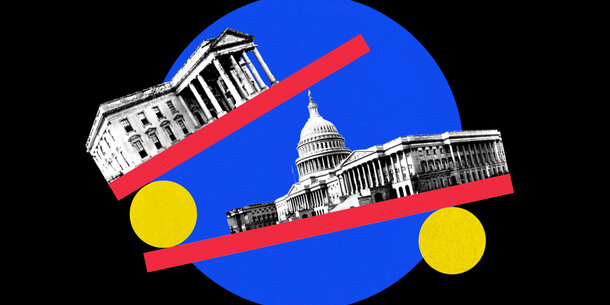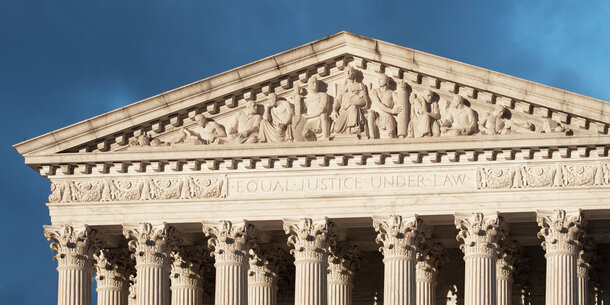After years of discussion and months of escalating pressure to address ethics concerns, the Supreme Court published a voluntary code of conduct on Monday signed by all nine justices.
The Court’s explanation of why it released a code for the first time in its history is illuminating, if not comforting. As stated in the introduction to the code, the justices adopted it not because they agree that they need a set of published rules to govern their conduct but because they want to “dispel” the public “misunderstanding” that the justices “regard themselves as unrestricted by any ethics rules.” And crucially, the Court failed to take any steps to create an enforcement mechanism for the rules it put forward.
The justices are demonstrating their own profound misunderstanding of the criticism they have been facing. The fact is that the rules — published or not — simply aren’t working to prevent the kind of troubling conduct that has been reported in the past several months. A steady stream of news stories has exposed the justices’ indulgence in undisclosed gifts, luxury travel, and other ethically questionable behavior, which has been going on for years but only coming to light now. The gifts are particularly distressing because they smack of corruption, calling into question the impartiality that is essential to public confidence in any court’s rulings.
To underscore the extent to which this code of conduct is fundamentally about optics, the justices plainly state that it “largely reflects a codification of principles” that they say already applied to them.
Should we take them at their word that this won’t really change anything?
No, but also yes.
Regardless of what the justices say, there is significance to having all of them sign their names to a code of conduct. When we, the public, seek to hold them accountable for their behavior, it is meaningful to be able to point to something specific that they have agreed applies to them. And the fact that they issued a code of conduct shows that they do feel pressure to at least be perceived as taking ethics seriously.
But the content of the code also reflects a missed opportunity for the Court to turn this appearance into reality. The new code doesn’t change the basic fact that each justice polices themself when it comes to complying with the rules. No outside person or group of people, either within the judiciary or outside of it, has the ability to step in and overrule a justice who decides they should or should not take a certain action based on the rules. Each justice has the absolute final say. That is the system that got us to where we are today.
Studying the specifics of the code of conduct also reveals some important ways in which it might make the ethics rules that apply to the Supreme Court weaker than they probably were before. Of course, there is some uncertainty in comparing a written code to standards that weren’t written down before, but there are indications that this code of conduct might actually establish a lower bar for the justices’ conduct.
The place where the rubber meets the road in terms of protecting the public from potential corruption is the code’s provisions about recusal, which it refers to as “disqualification.” This rule governs whether a justice participates in deciding a case.
A close examination of how the justices have written their disqualification rules — and of their justification for why the rules are the way they are — shows that the Court’s members continue to hold themselves to lower ethics standards than all other federal judges.
The justices put a big loophole in the disqualification rule — possibly a loophole that renders the whole rule toothless. To see how this works, compare the rule that the justices wrote for themselves to the one that applies to lower court federal judges. The lower court rule starts with a basic statement: “A judge shall disqualify himself or herself in a proceeding in which the judge’s impartiality might reasonably be questioned.” It then goes on to list examples of when that might be true, such as when a judge has personal knowledge about disputed facts in a case, when a judge previously worked as a lawyer in a case, or when a judge has a financial interest that could be substantially affected by a case’s outcome.
The Supreme Court’s version starts out quite differently: “A Justice is presumed impartial and has an obligation to sit unless disqualified.” So, before even requiring disqualification, the justices put a thumb on the scale. Plus, the language requiring disqualification is weaker: “A Justice should [emphasis added] disqualify himself or herself in a proceeding in which the Justice’s impartiality might reasonably be questioned.” After including similar (but somewhat weaker) language with examples, the Supreme Court code includes another thumb on the scale against disqualification, noting, “The rule of necessity may override the rule of disqualification.”
What is this undefined exception, “the rule of necessity”? In general, the rule of necessity means that if the ethics rules say a judge should be disqualified from a case, but no other judge is available to decide it, then that judge can participate in the case. In their commentary, the justices argue that the recusal of a Supreme Court justice is fundamentally different from the recusal of a lower court judge, so the rules should also differ. The justices declare that “the loss of even one Justice may undermine the ‘fruitful interchange of minds which is indispensable’ to the Court’s decision-making process,” whereas lower courts “can freely substitute one district or circuit judge for another.” They also project potential “distorting effects” on cases if one justice does not take part because of majority vote rules, including potentially “preventing the Court from providing a uniform national rule of decision on an important issue.”
It makes sense for the Court to consider these issues when adopting its code of conduct. Two competing interests must be balanced against each other: the potential harms to the Court’s work when justices do not participate and the potential harms to the Court’s work when a biased justice does participate. But simply inserting the rule of necessity into the disqualification section fails to do this.
For one thing, the new code of conduct fails to provide any guidance for when the application of the rule of necessity might be appropriate. As a practical matter, it is hard to see how a justice would know whether the rule of necessity should or shouldn’t prevent an otherwise appropriate recusal — or how the public can assess the decision, since each justice decides their own recusal and need not explain their reasoning.
But taking seriously the rule of necessity as a principled standard, not just a get-out-of-jail-free card, should also lead to changes elsewhere in the code of conduct. If the negative impact of a justice disqualifying from a case is so substantial, it would make sense for the code to include steps to prevent that from being needed. Instead, the code contains no changes to the rules about financial interests, gifts, or any of the other areas that might help reduce the number of situations in which recusal would even be an issue. Strengthening those preventative measures would be a meaningful response to the Court’s concerns about not having enough justices to properly decide a case.
It’s impossible to say whether the “rule of necessity” will ultimately prove to be a loophole so big that it effectively nullifies the disqualification rule by allowing justices to exercise their power even when they are ethically compromised. But the newly unveiled code of conduct provides little solace — both in terms of the specifics of the recusal rule and, more broadly, in the fact that the justices apparently believe this to be a sufficient response to the public’s concerns about ethics at the Court. It is reassuring that the justices have heard those concerns, but it is less clear that they have truly understood them.



